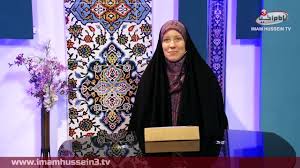Amina Inloes
Amina Inloes | |
|---|---|
 | |
| Nationality | American |
| Occupation | scholar, researcher, educator, public speaker, translator |
Amina Inloes is an American scholar, researcher, educator, public speaker, translator and a Shi'ite Muslim. She was born in Irvine, California, United States.
Education[edit | edit source]
- MA degree in Islamic Studies from the Islamic College , 2009
- PhD in Islamic Studies at Exeter University on Shi'ia hadith about pre-Islamic female figures mentioned in the Qur'an, 2015
Career[edit | edit source]
- works for the Research Department of the Islamic College
- leader of the Master of Islamic Studies program
Books and articles[edit | edit source]
Books[edit | edit source]
- Authentication of hadith on the Raj’ah
- The Tragedy of Karbala: A Dramatic Interpretation of the Epic of Imam Husain
Articles[edit | edit source]
- Was Imam ‘Ali a misogynist?
- The queen of Sheba in Shi’a hadith , in Journal of Shi’a Islamic Studies, 2012
- Mukhtar al-Thaqafi: Character versus Controversy, Journal of Shi’a Islamic Studies, 2009
- Inloes and L. Takim, ‘Conversion to Twelver Shi‘ism among American and Canadian women, Studies in Religion
- Zain Al Husain Moloobhoy, Amina Inloes, Marjaʿiyya in the digital era: Renegotiating the relationship between marjaʿ and muqallid in the era of the democratization of knowledge , 2021
- Muhammad Abd al‐Rahman (Phillip) Barker: Bridging Cultural Divides through Fantasy/Science‐Fiction Role‐Playing Games and Fictional Religion , 2021
- Liyakat Takim, Inloes, Conversion to Twelver Shi'ism among American and Canadian women , 2021
- Was Imam 'Ali a Misogynist? The Portrayal of Women in Nahj al-Balaghah and Kitab Sulaym ibn Qays , 2021
- Racial ‘Othering’ in Shi‘i Sacred History: Jawn ibn Huwayy ‘the African Slave’, and the Ethnicities of the Twelve Imams, Journal of Shi'a Islamic Studies, Volume 7, Number 4, Autumn 2014, pp. 411-439
Activities in media[edit | edit source]
- Islam: Self-Sacrifice or Tribalism? , 2015
- In The Footsteps of Sayyida Zaynab , Why Zaynab ?
- Comparing Models of Femininity: Fatimah Al-Zahra' and A'isha'
- In The Footsteps Of Sayyida Zaynab 6/9 - Her Steps Into The Eyes Of History
- Islamic Leadership - 2nd Muharram,2015
- In The Footsteps Of Sayyida Zaynab , Her Patience
- Race & Gender in how we portray Karbala
- In The Footsteps Of Sayyida Zaynab , The Power Of Dignity
- Islamic Selfishness - 3rd Muharram
- In The Footsteps Of Sayyida Zaynab , Her Learning
- Prophet Isa (A) and Imam Husayn (A) in Ziyarat Warith
- In The Footsteps Of Sayyida Zaynab , The Power Of Truth
- Is There Redemptive Suffering In Islam? - 4th Muharram
- In The Footsteps Of Sayyida Zaynab 4/9 - Journey To Karbala'
- Why Don’t We Know Much About the Life of Imam Hasan al-Askari (A)?
- In The Footsteps Of Sayyida Zaynab , Unseating The Tyrant
- A Look Into The Life Of Ali Akbar
- In The Footsteps Of Sayyida Zaynab , Zaynab (A) On The Day Of Ashura'
Her vision towards Karbala[edit | edit source]
In one of her speeches called “ Race And Gender In How We Portray Karbala” , she discussed this matter that how we interpret tragedy of Imam Hussain personally, and we don’t take religious rituals of Ashura seriously by just crying and passing the day. She mentioned that crying is a good thing if we know what we are crying for. In this speech she highlighted the power of portrayal in Iran in two elements: 1. 19th century; Iranian Ta’ziya and 2. Ali Shari’ati’s “Fatima is Fatima”. She proposed this idea that we need to take off our cultural lenses and try to understand the real massage of Karbala in addition to, answering these questions:
What actually happened?
What are Historical reports/narrations?
What was Abbasid era cultural filter?
What was Ottom – Safavid era cultural filter?
What is Modern worldview?
What impact does Cultural lenses have on our understanding?
In another speech of hers called “ Prophet Isa (A) And Imam Husayn (A) In Ziarat Warith” , she talked about how we should do Ziarat and also prophets’ opinion upon Ziarat addition to the relation between Imam Hussain and Adam Prophet. She introduced Imam Hussain as an inherit of Adam Prophet due to the fact that both had same situation and also fought against injustice. She mentioned Adam’s mistake and how he was forgiven through 5 names of “ Be haqe Mohammad, Ali , Fateme, Hasan and Hussain ( Adam (A) was made to disobey Allah by eating an apple from forbidden tree in heaven , then they begged Allah to forgive them by swearing an oath upon these 5 names to be forgiven).
On 5th of Muharram , she had another speech in Hananeh mosque , called Zaynab (A) On The Day Of Ashura, first she explained the real pain of Ashura for Muslims as the day of sacrifice , the day on which heavens rained blood based on Qu’ran , then she explained the characteristics of Sayyida Zeynab like faith , wisdom , knowledge, patience , eloquence and etc. But we could see the reality of these things in Karbala against the enemy and the lost they caused.
And finally, she published her book as “The Tragedy of Karbala: A Dramatic Interpretation of the Epic of Imam Husain”.